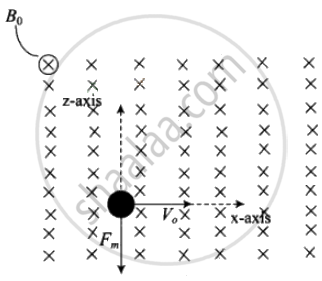Advertisements
Advertisements
प्रश्न
An electron is moving with an initial velocity `v = v_0hati` and is in a magnetic field `B = B_0hatj`. Then it’s de Broglie wavelength ______.
विकल्प
remains constant.
increases with time.
decreases with time.
increases and decreases periodically.
उत्तर
An electron is moving with an initial velocity `v = v_0hati` and is in a magnetic field `B = B_0hatj`. Then it’s de Broglie wavelength remains constant.
Explanation:
If a particle is carrying a positive charge q and moving with a velocity v and enters a magnetic field 5 then it experiences a force F which is given by the expression
F = q(v × B) = $ F = qvB sin θ. As this force is perpendicular to v and B, so the magnitude of v will not change, i.e. momentum (p = mv) will remain constant in magnitude.
According to the problem, `vecv = v_0i` and `vecB = B_0j`
Magnetic force on moving electron = `-e[v_0i xx B_0j] ⇒ - ev_0B_0k`

As this force is perpendicular to `vecv` and `vecB`, so the magnitude of v will not change, i.e. momentum (p = mv) will remain constant in magnitude. Hence, de-Broglie wavelength `lambda = h/(mv)` remains constant.
APPEARS IN
संबंधित प्रश्न
Describe the construction of photoelectric cell.
A proton and an α-particle have the same de-Broglie wavelength Determine the ratio of their speeds.
What is the
(a) momentum,
(b) speed, and
(c) de Broglie wavelength of an electron with kinetic energy of 120 eV.
What is the de Broglie wavelength of a bullet of mass 0.040 kg travelling at the speed of 1.0 km/s?
Crystal diffraction experiments can be performed using X-rays, or electrons accelerated through appropriate voltage. Which probe has greater energy? (For quantitative comparison, take the wavelength of the probe equal to 1 Å, which is of the order of inter-atomic spacing in the lattice) (me = 9.11 × 10−31 kg).
Compute the typical de Broglie wavelength of an electron in a metal at 27°C and compare it with the mean separation between two electrons in a metal which is given to be about 2 × 10−10 m.
An electron (mass m) with an initial velocity `v = v_0hati (v_0 > 0)` is in an electric field `E = - E_0hati `(E0 = constant > 0). It’s de Broglie wavelength at time t is given by ______.
Relativistic corrections become necessary when the expression for the kinetic energy `1/2 mv^2`, becomes comparable with mc2, where m is the mass of the particle. At what de Broglie wavelength will relativistic corrections become important for an electron?
- λ = 10 nm
- λ = 10–1 nm
- λ = 10–4 nm
- λ = 10–6 nm
A proton and an α-particle are accelerated, using the same potential difference. How are the de-Broglie wavelengths λp and λa related to each other?
Two particles move at a right angle to each other. Their de-Broglie wavelengths are λ1 and λ2 respectively. The particles suffer a perfectly inelastic collision. The de-Broglie wavelength λ, of the final particle, is given by ______.
